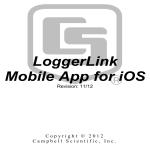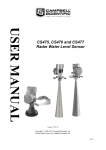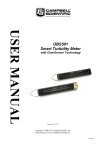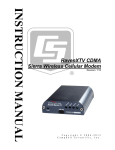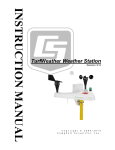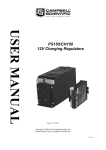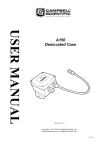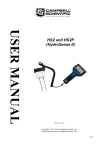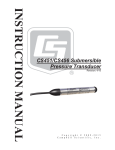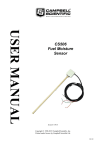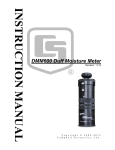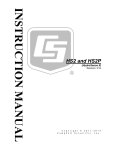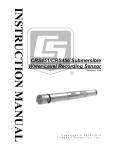Download LoggerLink Mobile App for Android Manual
Transcript
LoggerLink Mobile App for Android Revision: 7/15 Copyright © 2012-2015 Campbell Scientific, Inc. Table of Contents Introduction ................................................................................................. 1 Requirements .............................................................................................. 1 Getting Started ............................................................................................ 2 Datalogger Setup ...................................................................................... 2 TCP Connection ................................................................................. 3 Bluetooth Connection ........................................................................ 4 Connecting ................................................................................................ 6 Connected ................................................................................................. 7 Disconnecting ........................................................................................... 7 Datalogger Setup—Settings ........................................................................ 8 Connecting ................................................................................................ 10 Current ...................................................................................................... 10 Status ......................................................................................................... 13 Historic...................................................................................................... 19 Collect Data .............................................................................................. 22 Files ........................................................................................................... 25 Settings ...................................................................................................... 28 Disconnect................................................................................................. 29 Off-line Files ............................................................................................. 29 LoggerLink Settings.................................................................................. 30 Backing Up and Restoring Your Network ................................................ 31 Copying Your Network to Another Android Device ................................ 32 End User License Agreement (EULA) for Mobile Applications ............. 33 i Introduction Please read the End User License Agreement (EULA). LoggerLink for Android™ is a simple yet powerful tool that lets you communicate directly with your IP-enabled or Bluetoothenabled CR6, CR3000, CR1000, CR800-Series, and CR200Series dataloggers from your Android device. The app lets you perform field maintenance tasks such as viewing and collecting data, setting the clock, and downloading programs. Note: AT&T’s default security settings do not allow mobile-tomobile connections on the AT&T network. This affects connections from a mobile phone or tablet on the AT&T network attempting to connect to a cellular modem on the AT&T network. If your mobile device and cellular modem are both on the AT&T network, communications between LoggerLink and the datalogger cannot be established. This does not affect connections where the phone and/or the modem are on another network (for instance, a Verizon phone connecting to an AT&T cellular modem or vice versa, or a Verizon phone to Verizon cellular modem connection). Requirements LoggerLink for Android runs on Android 4.0.3 (Ice Cream Sandwich) or greater. 1 TOC Getting Started When LoggerLink is launched, you can add new dataloggers by tapping the “+” button in the upper right corner of the screen. Note that to use a TCP connection, your Android device must be connected to a network through which you can reach your datalogger. To use a Bluetooth connection, you must have an RS-232 to Bluetooth adapter connected to your datalogger’s RS-232 port. The Bluetooth adapter must be properly configured according to the manufacturer’s instruction manual. See Bluetooth Connection below for information on settings. Some LoggerLink functions are accessed from your Android device’s Menu button. If your device does not have a Menu button, these functions can be accessed from the menu button on the right end of the action bar at the top of the LoggerLink screen. Datalogger Setup Note that you can only specify a TCP or a Bluetooth connection for a single datalogger. If you enter information in the TCP Settings, any previous Bluetooth Settings will be cleared. If you select a Bluetooth connection, any previous TCP Settings will be cleared. 2 TOC TCP Connection Depending on how your datalogger is connected to the Internet, you may be able to use the UDP or PB discovery buttons to set up your datalogger. If your network supports UDP, simply tap the UDP discovery button next to the TCP Address field. LoggerLink will return a list of PakBus dataloggers that it discovers. Tap a datalogger in the list to have its settings automatically filled in to the Datalogger Setup screen. After manually filling in any additional settings, tap the Save button to add the datalogger. If your network does not support UDP, you may be able to use the PakBus discovery button to set up your dataloggers. Simply type in the IP Address and Port, and then tap the PB discovery button next to the PakBus Address field. LoggerLink will return a list of PakBus dataloggers that are reachable from that IP address. Tap a datalogger in the list to have its settings automatically filled in to the Datalogger Setup screen. After manually filling in any additional settings, tap the Save button to add the datalogger. If you are not able to use UDP or PakBus discovery, you will need to manually enter the information about how LoggerLink will connect to your datalogger. 3 TOC Bluetooth Connection Press the Bluetooth button at the top of the screen. LoggerLink should automatically search for Bluetooth devices. If not, press the discovery button next to the Bluetooth Name field. It can take up to 12 seconds for device names to be returned. Select the Bluetooth device from the list returned by LoggerLink. Note that you cannot manually enter the Bluetooth settings. A device must be selected from the list returned by LoggerLink. Once a Bluetooth device has been selected, you may be able to use the PakBus discovery button to set up your datalogger. Simply tap the PB discovery button next to the PakBus Address field. LoggerLink will return a list of PakBus dataloggers that are reachable from that Bluetooth device. Tap a datalogger in the list to have its settings automatically filled in to the Datalogger Setup screen. After manually filling in any additional settings, tap the Save button to add the datalogger. The baud rate of the RS-232-Bluetooth adapter must match that of the datalogger. Handshaking should be disabled in the adapter. (If that is not possible, handshaking must be enabled in the datalogger.) Depending on the adapter, there may be other settings that need to be set correctly for proper communication. Refer to the manufacturer’s instruction manual. 4 TOC See the Datalogger Setup section for an explanation of each field on the Datalogger Setup screen. After you have finished setting up a datalogger, it will show up in the list of dataloggers when LoggerLink is launched. You can view a datalogger’s settings by tapping on the “i” button on the right side of the datalogger. You can edit a datalogger’s settings by tapping the “i” button, and then tapping the pencil icon on the upper right. You can delete a datalogger by tapping the “i” button, tapping your device’s Menu button, and then selecting Delete Datalogger. 5 TOC Connecting To connect to a datalogger, simply tap on it in the list of dataloggers. 6 TOC Connected After you have connected with your datalogger, a set of tabs will appear at the top of the screen. Tapping on these tabs will allow you to perform different operations on your datalogger such as viewing data in a tabular or graphical format, monitoring status, and collecting data. If you leave LoggerLink or your device goes to sleep while connected to a datalogger, you will be automatically disconnected from the datalogger 10 minutes after any background processes (such as data collection) complete. Note that if you have Prevent Sleep enabled (see the LoggerLink Settings section) your device will not automatically go to sleep while you are connected to a datalogger. You must put the device to sleep manually or disconnect from the datalogger. Disconnecting When you are finished interacting with your datalogger, tap your device’s Menu button and select Disconnect (or simply tap your device’s back button) to disconnect and return to the list of dataloggers. 7 TOC Datalogger Setup—Settings TCP Settings Address The TCP/IP Address of the device you will be communicating with. Port The TCP/IP Port the device is accepting connections on. This defaults to 6785. Bluetooth Settings Note that the Bluetooth Name and Address must be selected from the list that LoggerLink returns after searching for Bluetooth devices. They cannot be entered manually. Name The Name of the Bluetooth device you will be communicating with. Address The Bluetooth Address of the device you will be communicating with. Datalogger Settings Type The Type of the datalogger you will be communicating with. 8 TOC Name The Name used to identify this datalogger in LoggerLink. Data files collected from this datalogger will be stored in a sub-directory with this name. Packet Size (Bluetooth Only) Data is transferred between the datalogger and LoggerLink in chunks called “packets”. This setting controls the maximum number of bytes in these packets. If you are experiencing problems maintaining a connection to a datalogger, try reducing the packet size. The packet size must be between 128 and 998. PakBus Settings 9 Address The PakBus Address of the datalogger you will be connecting to. The valid range is 1 through 4094. However, PakBus addresses greater than 3999 are typically reserved for PakBus routing devices and ports. Neighbor The PakBus address of the neighbor you will go through to connect to your datalogger. A value of 0 means you will connect directly to your datalogger. Security Code The Security Code is only required if security has been enabled on your datalogger. In order for LoggerLink to connect to a security-enabled datalogger, the security code of at least level 3 is required. The level 3 security code TOC allows you to check the clock and collect data. The level 2 security code is required to set the clock or change public variables. The level 1 security code unlocks the highest level of security and allows you to change or retrieve the program as well as change status table variables. TCP Password If you are trying to connect via TCP to a datalogger with a TCP Password enabled, you must enter the password in order for any communications to occur with the datalogger. Encryption Key This setting specifies text that will be used to generate the key for encrypting PakBus messages sent or received by this datalogger. The key entered here must match the PakBus Encryption Key setting in the device. Connecting To connect to a datalogger, simply tap on the datalogger in your list of dataloggers or tap the Connect button while viewing the datalogger’s settings. When connecting to a datalogger, a clock check is sent to see if communications can be established. On the first connection, table definitions are retrieved and stored. Table definitions are only retrieved again, if a change is detected. Current 10 The current page displays the current data record for the selected table. TOC Tap the icon in the upper right corner to select and configure a different table. 11 TOC Values are formatted based on type and, by default, include the units defined in the datalogger program. Touch and hold a settable value to open a page that allows you to change the value. Boolean values can be changed by tapping the On checkbox. Current Setup Selected Table Select the table that will be displayed. Select Fields Select the fields that will be displayed. Polling Interval Select the interval at which the data will be updated. The LoggerLink App will never poll faster than 1 time per second. Show Units Use the check box to specify whether or not units are displayed. Field Options Each field may be edited. Tap the button to the right of the field name. This will display customization options for that particular field. These options include: Title The name that will be displayed for the field. Units The measurement units that will be displayed for the field. 12 TOC Precision The number of digits of precision used. (Only displayed if the field value is floating point type.) Status The status page shows important information about your datalogger, the current program, errors, card status, the battery, and the clock. It also allows you to send a program to your datalogger. 13 TOC 14 TOC Program Info Current The program currently running in the datalogger. Started The date the currently running program was started. Signature Signature of the compiled binary data structure for the current program. This value is independent of comments added or non-functional changes to the program. Compile Results The results reported by the datalogger when it compiled the currently running program. Send Program Click to send a new program file to the datalogger. The file must be accessible to the LoggerLink App. (Programs to be sent to your datalogger must be stored on your device in the Campbellsci/Programs directory. With your device connected to a computer as a disk drive, you can navigate to this directory to copy files to your device from the computer.) When Send Program is clicked, a list of available files is displayed. When a file is selected, it will be sent, compiled, and assigned the Run Options of Run Now and Run on Power-up. 15 TOC Datalogger Info Station Name A name assigned to this datalogger. Note that this is the station name internal to the datalogger. It is not the name given to the datalogger in LoggerLink. OS Version Specifies the version of the operating system currently in the datalogger. OS Signature The signature of the current operating system. Model No The type of datalogger. Serial No Specifies the datalogger serial number assigned by the factory when the datalogger was calibrated. Power Up The program that is flagged to run when the datalogger is powered off and back on again. Compile State The state of the program after the datalogger tried to compile it. Possible states are: No Program, Program Running, Compile Failed, Program Paused, or Unknown. Panel Temperature Current panel temperature measurement. This measurement is made in the background calibration. Run Signature Signature of the current running program file. 16 TOC Memory Size The total amount of SRAM in the datalogger. Memory Free The amount of unallocated memory on the CPU (SRAM). All free memory may not be available for data tables. As memory is allocated and freed, holes of unallocated memory, which are unusable for final storage, may be created. Errors Watchdog Errors The number of internal watchdog errors that have occurred while running the current program. Skipped Records The number of records that have been skipped for a given table. Skipped records are normally caused by skipped scans. Low 12V Count The number of occurrences of the 12VLow signal being asserted. When this condition is detected, the datalogger ceases measurements and goes into a low power mode until proper system voltage is restored. Low 5V Count The number of occurrences of the 5VExtLow signal being asserted. 17 TOC Skipped Scans The number of skipped scans that have occurred while running the current program. Does not include scans intentionally skipped as may occur with the use of ExitScan and Do...Loop instructions. Skipped System Scans The number of scans skipped in the background calibration. Skipped Slow Scans The number of scans skipped in a SlowSequence. Variable Out of Bounds The number of times an array was accessed out of bounds. Battery Info Battery The current value of the battery voltage. This measurement is made in the background calibration. Lithium The current voltage of the lithium battery. This measurement is updated in background calibration. Card Info Card Status Reports the status of the CF card. Bytes Free The amount of space still available on the CF card. 18 TOC Clock Info System The local time of your device the last time the datalogger clock was checked. Logger The time reported by the datalogger the last time its clock was checked. Set Clock Click to set the datalogger clock. You can choose to either manually set the datalogger clock or to set the datalogger clock to your device’s clock. An attempt will be made to set the clock as closely as possible to the desired time, but there may be some difference due to delay in the communication link. This option should be used with caution, since it could result in missing or duplicate timestamps when the datalogger clock is changed. Historic The historic page displays data from a single datalogger table in graph or tabular form. 19 TOC The first time you open the historic window for a datalogger, you will automatically be taken to the Historic Setup. This allows you to select the table and fields to be displayed. An 20 TOC option for showing the legend is also available. You can tap Data Range to change the data range that will be displayed. (The default data range is 1 hour.) Once fields have been selected, you can tap on the name of a field to set the display options for that field as described below. After completing the setup, tap Save to display your selected data. From the main Historic screen, tap Graph or Table at the top to choose how to display your data. Tap the icon in the upper right corner to go to Historic Setup and change the table, fields, data range, or field options. On a Graph, tap a point on the graph to display the data value and timestamp at that point. You can zoom in on a part of the graph by touching the screen with two fingers and then sliding your fingers apart. You can zoom out by pinching your fingers together. You can pan the graph by using one finger to drag the graph to the desired location. A zoomed or panned graph can be restored by selecting the Restore icon at the top. On the table, the current data will be displayed in tabular format. You may sort the data by time simply by tapping the Time column heading. Historic Setup Select Table/Fields Select the table and fields that will be displayed in the graph and table. 21 TOC Show Legend Determines whether a legend is shown on the graph. Data Range The range of data to be displayed in the graph and table. Field Options Field Title The title used in the graph legend and the table column heading. Graph Axis Each series can be displayed using the left or right axis of the graph. Graph Line Width The width of the line used for the graph series. Graph Line Color The color of the line used for the graph series. Graph Line Style The style of the line used for the graph series. Graph Symbol Size The size of the symbol used for the graph series. Graph Symbol Color The color of the symbol used for the graph series. Graph Symbol Style The style of the symbol used for the graph series. Collect Data The Collect Data page is used to download data from your datalogger and store it in data files on your device. These data 22 TOC files can then be viewed, emailed from your device, or opened in another application. 23 TOC Collected data files are stored on your device in the Campbellsci/Data/name directory, where name is the name given to your datalogger when it was added to the LoggerLink App. With your device connected to a computer as a disk drive, you can navigate to this directory to copy your data files to the computer. Collection Option Choose whether to collect All Data and overwrite existing data files, only New Data and append the data to the end of existing data files, or the Most Recent records. If you select Most Recent, you specify the number of records to collect or the time interval of records to collect. You also specify whether to overwrite existing data files or append to the end of existing data files. Datalogger Tables A list of all the datalogger tables that can be selected for data collection. Select the table(s) you wish to collect and tap the Collect button. You can view collected data files by tapping the eye icon next to the table name. While viewing a data file, you can tap the information icon at the top to get information about the datalogger that generated the data, the datalogger program, and the data fields. Tap the historic icon at the top to graph your data. You will be asked to select the fields and data range to graph. Tap the share icon at the top to share the file through email or a file-sharing application such as DropBox. Tap your device’s Menu button and then select Delete File to delete the data file. 24 TOC Files The Files page is used to view the drives on your datalogger as well as pause/resume the currently running program. You can also view and edit files on your datalogger, send files to your datalogger, get files from your datalogger, or set the run options for a program file on your datalogger. Current Program Resume The Resume button restarts the paused program while preserving data files. Pause The Pause button pauses the currently running program and preserves data files. Drives The drives on the datalogger. Selecting one of the drives displays a list of all the files on the drive. File List You can refresh the list of all drives and files from the datalogger by tapping the refresh icon in the upper right corner. Other functions are available by tapping your device’s Menu button. (If your device does not have a Menu button, the functions can be accessed by using the menu button in the 25 TOC upper right corner.) If no files are selected, you have the option to format the drive or send files to the datalogger from your device. If you have selected files, you can delete the selected files from the datalogger or get the selected files from the datalogger and save them to your device. If only a single program file is selected, you also have the ability to view the selected file or set the file’s run options. Format Drive Formatting an individual drive on the datalogger will permanently delete all the files on that drive. If the currently running program is found on the drive being formatted, you will not be able to format the drive until the Run Options on the running program are cleared. Send File(s) Files can be sent from your device to the datalogger. Selecting this option will display a list of local files you can select to send to the datalogger. (Files to be sent to your datalogger must be stored on your device in the Campbellsci/Programs directory. With your device connected to a computer as a disk drive, you can navigate to this directory to copy files to your device from the computer.) Delete File(s) After selecting files from the datalogger file list, you can delete the files from the datalogger. 26 TOC Get File(s) After selecting files from the datalogger file list, you can get the files from the datalogger and store them on your device. (Retrieved files are stored on your device in the Campbellsci/Data/name directory, where name is the name given to your datalogger when it was added to the LoggerLink App. With your device connected to a computer as a disk drive, you can navigate to this directory to copy your retrieved files to the computer.) View File After selecting a file from the datalogger file list, you can view the file. While viewing a file, you can make edits. You can then tap the disk icon on the upper right to save the file to your device or to the datalogger. This allows you to edit a program on your datalogger. Note that if you edit the running program and save it to your datalogger, it will cause the program to be recompiled. While viewing a file, you can also tap the share icon on the upper right to share the file. This will show a list of installed applications that are registered to handle the current file type. This can be used to email the file, or, if you have a file-sharing application, such as Dropbox, this option can be used to get the file to your computer. Run Options When Run Now is selected, the program will be compiled and run in the datalogger. You may also choose to preserve existing data tables on the datalogger, if there are no 27 TOC changes to the table structure of the new program. The Run On Power-up will set this program file to run when the datalogger loses power and then powers back up. Settings The Settings page is used to view and/or change the internal settings of the datalogger. If needed, each setting has detailed help available by tapping the “i” button next to the setting. Writable values will have an arrow next to the value that can be tapped to change the value. Once changes have been made to any setting(s), they must be applied to the datalogger by tapping the Apply button in the upper right corner. Applying changes stores them to the datalogger. Any setting that has been changed but not applied will have an asterisk next to the setting name. When you leave the Settings tab, any changes that have not been applied will be lost. The following options are available by tapping your device’s Menu button while in the Settings window. Refresh When the Refresh option is selected, the datalogger settings will be retrieved and any pending setting changes will be discarded. Factory Defaults When the Factory Defaults option is selected, the datalogger settings will all be set back to their factory default values. 28 TOC Disconnect When you are finished interacting with your datalogger, tap your devices’s Menu button and select Disconnect (or simply tap your device’s back button) to disconnect. Disconnecting from a datalogger will end all communications with that datalogger and take you back to your list of dataloggers. Off-line Files Pressing the folder button at the top of the main LoggerLink screen (i.e., when you are not connected to a datalogger) will display the files on your device that are associated with LoggerLink. Tapping the Data folder will display a subfolder for each device that has collected data files or retrieved image files. Tapping a device sub-folder will display the data and image files from that device. The Log folder contains a log file for each device, if logging is enabled. The Program folder contains all program files retrieved from all dataloggers. (This folder is also where you should store program files that you copy from your computer to your device.) The TableDefinitions folder holds the table definitions file for each device. 29 A single datalogger’s files are also directly accessible by tapping the folder icon at the top of the datalogger’s information page (i.e., the page that is displayed by tapping the “i” button next to the datalogger in the list of dataloggers). TOC Clicking the eye icon next to a file allows you to view that file. While viewing a program file, you can edit the file and then tap the disk icon in the upper right corner to save the file to your device. While viewing a data file, tap the historic icon at the top to graph your data or the share icon at the top to share the file through email or a file-sharing application such as DropBox. Pressing your device’s Menu button with file(s) selected in a list of files allows you to delete the file(s) or share the file(s) through email or a file-sharing application such as DropBox. If only one file is selected, you also have the option to rename the file or view the file. LoggerLink Settings The following settings for the LoggerLink app can be viewed and/or set by tapping your device’s Menu button from the main LoggerLink screen (i.e., when you are not connected to a datalogger) and selecting LoggerLink Settings. Settings: Global Address The PakBus address for this device. Each device in a PakBus network must have a unique address. Valid PakBus addresses are 1 through 4094. Typically, software such as LoggerLink should use a value greater than 3999. This is because, when a neighbor filter is set up, a PakBus datalogger will answer a Hello message from any device 30 TOC with an ID greater than 3999, but will ignore devices with IDs less than 4000 that are not in their neighbor list. Settings: Prevent Sleep The Prevent Sleep setting will prevent your device from going to sleep when connected to a datalogger. Troubleshooting: Logging Enabled Enabling logging will create a low level log file of all communications with a datalogger. Note that enabling logging will slow down LoggerLink. Logging should only be enabled, if you are experiencing communication problems. Log files are stored on your device in the Campbellsci/Logs directory. The filename is name.log, where name is the name given to your datalogger when it was added to the LoggerLink app. With your device connected to a computer as a disk drive, you can navigate to this directory to copy your log files to the computer. Information: Version The version of LoggerLink. Backing Up, Restoring, and Copying Your Network Backing Up and Restoring Your Network Your LoggerLink datalogger network can be backed up by pressing your device’s menu button and selecting Backup Network. This creates a loggerLink.bkp file in the 31 TOC Campbellsci/LoggerLink directory. Once a backup file has been created, the network can be restored at any time by pressing your device’s menu button and selecting Restore Network. Note that this will overwrite any existing stations. Copying Your Network to Another Android Device You can copy your datalogger network to another Android device by copying the loggerLink.bkp file described above to the Campbellsci/LoggerLink directory on the new device. (Note that LoggerLink must be installed and run on the second device, before the Campbellsci/LoggerLink directory will be created.) Once the file has been copied to the new device, press the device’s menu button and select Restore Network. Note that if the new device already has a datalogger network, this will overwrite any existing stations. 32 TOC End User License Agreement (EULA) for Mobile Applications NOTICE OF AGREEMENT: Please carefully read this EULA. By installing or using this software, You are agreeing to comply with the following terms and conditions. If you do not want to be bound by this EULA, You must promptly remove the Licensed Application and any versions thereof from your mobile device. By accepting this agreement, you acknowledge that this agreement is concluded between You and Campbell Scientific, Inc. only, and no other third parties. As such, Campbell Scientific, Inc. is solely responsible for the Licensed Application and the content thereof, and reserves all rights not expressly granted to You. DEFINITIONS: Licensed Application – The mobile application developed by Campbell Scientific, Inc., that is subject to this EULA. Mobile Device – Any smart phone, tablet or other device defined as a supported device in Campbell Scientific, Inc.’s product literature, website, or Application Store presence. Application Store – The Application Store refers to the Apple Store, Google Play, or other distribution channel for the Licensed Application. 33 TOC LICENSE FOR USE: The Licensed Application is licensed, not sold, to you for use under the following terms and conditions: Scope: This license is limited to a non-transferable license to use the Licensed Application on any supported mobile device that You own or control. This license does not allow You to use the Licensed Application on any device that You do not own or control, and You may not distribute or make the Licensed Application available over a network where it could be used by multiple devices at the same time. You may not rent, lease, lend, sell, redistribute or sublicense the Licensed Application. You may not copy, decompile, reverse engineer, disassemble, attempt to derive the source code of, modify, or create derivative works of the Licensed Application, any updates, or any part thereof (except as and only to the extent any foregoing restriction is prohibited by applicable law). Any attempt to do so is a violation of the rights of Campbell Scientific, Inc. If You breach this restriction, You may be subject to prosecution and damages. The terms of this license will govern any upgrades provided by Campbell Scientific, Inc. that replace and/or supplement the original Licensed Application, unless such upgrade is accompanied by a separate license in which case the terms of that license will govern. Consent to Use of Data: You agree that Campbell Scientific, Inc. may collect and use technical data and related information that is provided by the Application Store, including but not limited to technical information about Your device, system and application 34 TOC software, and peripherals, that is gathered periodically to facilitate the provision of software updates, product support and other services to You (if any) related to the Licensed Application. Campbell Scientific, Inc. may use this information, as long as it is in a form that does not personally identify You, to improve its products or to provide services or technologies to You. MAINTENANCE AND SUPPORT: Campbell Scientific or its Companies are responsible for any maintenance and support services with respect to the Licensed Application as required by law. No other third party, including Apple or Google, has any obligation to furnish maintenance and support services with respect to the Licensed Application. Requests for maintenance, support, or other inquiries should be addressed to Campbell Scientific, Inc. or a Campbell Scientific company covering your region, as noted in CAMPBELL SCIENTIFIC COMPANIES below. WARRANTIES: Campbell Scientific, Inc. is solely responsible for addressing any claims You may have relating to the use of the Licensed Application. The following warranties are in effect for thirty (30) days from the date of original purchase. These warranties are not extended by the installation of upgrades. Campbell Scientific warrants that the software itself will perform substantially in accordance with the specifications set forth in the user manual when properly installed and used in a 35 TOC manner consistent with the published recommendations, including recommended system requirements. CSI disclaims all other warranties including those implied at law. Campbell Scientific does not warrant that the software will meet Your requirements for use, or that the software or documentation are error free, or that the operation of the software will be uninterrupted. You expressly acknowledge and agree that use of the Licensed Application is at Your sole risk and that the entire risk as to satisfactory quality, performance, accuracy and effort is with You. This warranty does not cover any software that has been altered or changed in any way by anyone other than Campbell Scientific. Campbell Scientific is not responsible for problems caused by computer or mobile device hardware, computer or mobile device operating systems, or the use of Campbell Scientific’s software with non-Campbell Scientific software or hardware. LIMITATION OF LIABILITIES: All warranties of merchantability and fitness for a particular purpose are disclaimed and excluded. Your sole and exclusive remedy is set forth in this limited warranty. In no event shall Campbell Scientific, Inc. be liable for personal injury, or any incidental, special, indirect or consequential damages whatsoever, including, without limitation, damages for loss of profits, loss of data, business interruption or any other commercial damages or losses, arising out of or related to your use or inability to use the 36 TOC Licensed Application, however caused, regardless of the theory of liability (contract, tort or otherwise) and even if Campbell Scientific, Inc. has been advised of the possibility of such damages. Campbell Scientific’s aggregate liability arising from or relating to this agreement or the software or documentation is limited to the purchase price paid by You. INTELLECTUAL PROPERTY RIGHTS: In the event of any third party claim that the Licensed Application or Your possession and use of that Licensed Application infringes that third party’s intellectual property rights, Campbell Scientific, Inc. will be solely responsible for the investigation, defense, settlement and discharge of any such intellectual property infringement claim. LEGAL COMPLIANCE: By accepting this agreement, You represent and warrant that You (i) are not located in a country that is subject to a U.S. Government embargo, or that has been designated by the U.S. Government as a “terrorist supporting” country; and (ii) are not listed on any U.S. Government list of prohibited or restricted parties. COPYRIGHT: This software is protected by United States copyright law and international copyright treaty provisions. This software may not be sold, included or redistributed in any other software, or altered in any way without prior written permission from Campbell Scientific. All copyright notices and labeling must be left intact. 37 TOC TERMINATION: This license is effective until terminated by You or by Campbell Scientific, Inc. Your rights under this license will terminate automatically with or without notice from Campbell Scientific, Inc. if You fail to comply with any term(s) of this license or this EULA. Upon termination of the license, You shall cease all use of the Licensed Application, and destroy all copies, full or partial, of the Licensed Application. 38 TOC Campbell Scientific Companies Campbell Scientific, Inc. 815 West 1800 North Logan, Utah 84321 UNITED STATES www.campbellsci.com • [email protected] Campbell Scientific Centro Caribe S.A. 300 N Cementerio, Edificio Breller Santo Domingo, Heredia 40305 COSTA RICA www.campbellsci.cc • [email protected] Campbell Scientific Africa Pty. Ltd. PO Box 2450 Somerset West 7129 SOUTH AFRICA www.csafrica.co.za • [email protected] Campbell Scientific Ltd. Campbell Park 80 Hathern Road Shepshed, Loughborough LE12 9GX UNITED KINGDOM www.campbellsci.co.uk • [email protected] Campbell Scientific Australia Pty. Ltd. PO Box 8108 Garbutt Post Shop QLD 4814 AUSTRALIA www.campbellsci.com.au • [email protected] Campbell Scientific Ltd. 3 Avenue de la Division Leclerc 92160 ANTONY FRANCE www.campbellsci.fr • [email protected] Campbell Scientific (Beijing) Co., Ltd. 8B16, Floor 8 Tower B, Hanwei Plaza 7 Guanghua Road Chaoyang, Beijing 100004 P.R. CHINA www.campbellsci.com • [email protected] Campbell Scientific Ltd. Fahrenheitstraße 13 28359 Bremen GERMANY www.campbellsci.de • [email protected] Campbell Scientific do Brasil Ltda. Rua Apinagés, nbr. 2018 ─ Perdizes CEP: 01258-00 ─ São Paulo ─ SP BRASIL www.campbellsci.com.br • [email protected] Campbell Scientific Spain, S. L. Avda. Pompeu Fabra 7-9, local 1 08024 Barcelona SPAIN www.campbellsci.es • [email protected] Campbell Scientific Canada Corp. 14532 – 131 Avenue NW Edmonton AB T5L 4X4 CANADA www.campbellsci.ca • [email protected] Campbell Scientific Southeast Asia Co., Ltd. 877/22 Nirvana@Work, Rama 9 Road Suan Luang Subdistrict, Suan Luang District Bangkok 10250 THAILAND www.campbellsci.asia • [email protected] Please visit www.campbellsci.com to obtain contact information for your local US or international representative. TOC









































